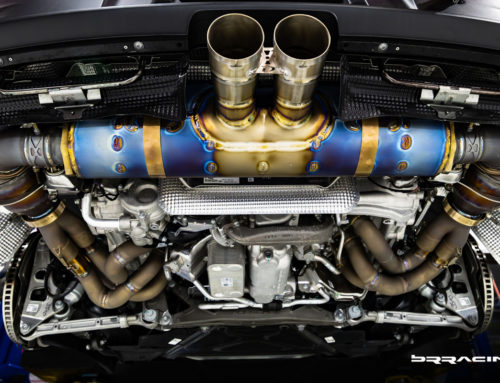Christmas came two weeks early for sports car fans when Audi revealed the R18, its new-for-2011 Le Mans racer, and even with just a cursory glance, the new coupe looks like a major step forward for the German marque.



Audi earned an astonishing 1-2-3 at Le Mans this year, but those within the team will readily admit that if not for Peugeot’s trio of twin-turbo diesel V12-powered 908s grenading in spectacular fashion, the R15 plus’ had little chance of landing on the podium.
The last time Audi held an advantage over Peugeot in the diesel wars was 2008, and even then the three-year-old Audi R10 was struggling to match the 908’s pace. Audi pressed a replacement for the twin-turbo diesel V12 R10 chassis into service a year earlier than scheduled, unveiling the V10-powered R15 at Sebring in 2009, and while it won its debut, the prototype was far from perfect.

While the Audi R10 drew heavily from the lessons learned with the venerable Audi R8, the R15 was a radical departure for the Germans. The biggest gains—or what they hoped would at least provide a marked improvement—came in the form of F1-style aerodynamics.
The Audi R15, drawing heavily on aero concepts employed by Ferrari, proved to be a mystery to the engineers at Audi. Not only was the car’s aerodynamics hard to predict, the new V10 engine also lacked power compared the brutal output Peugeot’s V12 offered.
After a thorough trouncing at Le Mans in 2009 at the hands of the factory 908s, Audi went back to work on the R15, developing the R15 ‘plus’ for 2010. The R15 plus could not escape some of the basic design deficiencies that limited the R15’s performance, but an emphasis on simplified aerodynamics—especially with a highly improved low-drag body configuration for Le Mans—shortened the gap to Peugeot. But it was still clear that a completely new car would be required to overtake their French rivals.
With the ACO’s (Le Mans sports car ruling body, and also for America Le Mans series) heavily revised 2011 LMP1 rules in place, the opportunity to start from scratch with a new prototype—the R18—gave Audi the chance to rid themselves of R15 at Le Mans in favor of what they unveiled on Friday.
Exact technical specifications for the R18 are highly limited, but after a thorough investigation, SPEED.com has learned a number of details about the car Audi hopes will conquer Peugeot’s new prototype, the 90X.
As you’ll find below, innovations and evolutions are found throghout the R18, and when it comes to the engine, Audi’s mad scientist of horsepower, Ulrich Baretzky, appears to have reached back almost three decades to build a style of engine that was last used by the likes of Gilles Villenueve and Didier Pironi.
1. Chassis
Audi worked with Dallara once again, tasking the Italian racing car manufacturer to produce the R18’s chassis and crash structure.
Not only did Audi make the move to producing a coupe—the first Audi Le Mans racer with a roof since the R8C in 1999—but they also moved the driver to the right side of the car for the first time.
Prior to the R18, drivers had to run to the far side of the car to enter the cockpit, but with the new car, egress and ingress will happen closest to the pit box at key circuits like Spa, Le Mans and Road Atlanta, which should save a fraction of time at each pit stop.
The use of a coupe was done out of sheer necessity. With the 2011 rules designed to rid LMP1 of the freakish engines that came to dominate the class, a premium was placed on achieving maximum aerodynamic efficiency due to the less powerful engines P1 teams will have at their disposal.
With less grunt to get down the straights, going to the smooth shape of a coupe was always going to be the choice Audi ended up making.
Adding a canopy to an open-top prototype might sound like a simple proposition, but Audi engineers have found a few challenges in shaping the windscreen. The cockpit of the R18 is somewhat larger than that of the 908 and 90X, forcing Audi’s drivers to sit farther back in the cabin.
The greater distance from the wind screen, along with its compound curves, has created a bit of distortion—similar to the ‘objects in mirror are closer than they appear’ warning that some automobiles have printed on their side mirrors—according to those who have driven the R18
Audi engineers have been working hard to overcome the distortion with a number of different windscreen shapes, and are reportedly considering adding a film to the screen that blocks out the distorted sections.
The film apparently acts in a manner similar to the privacy screen protectors found on computer monitors that prohibit others from seeing what’s on the screen unless they are looking straight ahead through the filter.
The R18 also sports air conditioning—another first—due to the regulations requiring AC in closed-cockpit cars.
At the front of the chassis, Audi has retained the ‘baguette’ crash structures, although the center section has been filled in-between the baguettes, and the center section extends to the edge of the nose, unlike the R15 plus.

The carbon-fiber tub is as narrow as possible at the front bulkhead, but additional strengthening has been done to carry the extra weight and forces the wide front tires and wheels provide. The R18’s chassis is also believed to continue the “zero-keel” design concept first seen on the Acura ARX-02a and later on the Audi R15.
The R15 plus, as requested by Audi, was lightened by Dallara, but it is believed the R18 has been spared the same process, which some felt made the R15 plus less robust.
The R18’s splitter, like the R15 plus, is made from machined aluminum, although it is now a more modular unit with a multitude of individual panels that comprise the entire unit. Where the R15’s splitter tended to rip away as one piece, causing damage to the floor while doing so, the R18’s splitter is expected to break away in pieces without subjecting the tub to unnecessary repairs.
The choice of aluminum was made again due to the team being unable to maintain the surface quality they desired. After being subjected to impacts from rocks and debris, the resulting pits from wear to the top and bottom of the splitter generated a surprising loss of downforce.

2. Drivetrain
Pictures of Audi’s new 3.7-liter turbo-diesel V6 engine have yet to be revealed, but if what SPEED.com has learned proves to be correct, the Germans could have a fun new engine on their hands—a turbo-diesel “bundle of snakes” exhaust configuration.
The 3.7-liter V6 unit, down from 2010’s 5.5 liter V10 power plant, is said to have a large, single turbo and a 120-degree V angle. The extremely wide V, we’re told, was done to house the exhaust pipes and turbo within the V—on top of the motor—while drawing in fresh air from the sides of the engine where the exhausts traditionally exit.
By moving the exhaust and turbo inside the V and moving the intakes low and outside of the engine, Baretzky has followed a turbo engine rchitecture last seen in F1 during the early 1980s. (Ferrari tried this w the engine in the 1981 F125C race car, but this has NOT been done on a diesel race car before).
With the use of one large turbo to make its horsepower, moving the exhaust/turbo arrangement inside the V allows for the shortest possible distance for the exhaust gasses to travel before spinning the turbocharger’s turbine wheel, providing vastly improved throttle response. This was also similar to the monster Porsche turbo cars that ran with the boxster design engine.
The Audi R18’s intercoolers are also said to be located closer to the engine, making the distance the compressed air needs to travel to the air intakes even shorter.
Feeding the engine’s air intakes and intercoolers (see more on this topic below under ‘Aerodynamics’) could also have a rather unusual solution in place. It is believed the meshed opening in the nose of the R18, amongst other things, feeds cold air to the turbo.
The overhead air inlet is believed to feed the intercoolers.
The choice of the 3.7-liter V6 is said to have been determined by internal studies by Audi on the best cylinder and capacity numbers-to-engine air restrictor ratios set by the ACO, rather than a choice made to align its Le Mans engine with a particular size of Audi road car engine. With the wide V8 angle and a lower crankshaft position within the block, the new engine is expected to be extremely compact.

Audi’s Baretzky has said on multiple occasions that he is not a fan of the V6 engine, but it appears the studies done by other departments within Audi Sport helped the marque to arrive at that architecture despite his protests.
Horsepower and torque figures—or any figures, for that matter—were not released by Audi, but we are told to expect the horsepower figures to stay somewhat close to the 650 hp the 5.5L V10 produced, while torque numbers are expected to come down drastically from the 1200 lb-ft the V10 generated.
It was suggested that the V6’s horsepower and torque figures could be very close to each other, while the RPM limit—just over 5000 on the V10—could rise to over 6000 on the 2011 TDI engine. Turbo boost pressures are also expected to rise significantly, possibly bringing back the much loved wastegate ‘chirp’ that has been lost during the last decade of sports car competition.
The weight of the V6 engine is also unknown, but we are told that the weight gain (or loss) by adding or removing cylinders on a diesel racing engine is somewhat linear.
The R10’s 5.5L V12 weighed in around 275 kilos, while the R15’s 5.5L V10 came in right at 225 kilos. At roughly 25 kilos per cylinder, the 3.7-liter V6 should weigh something in the neighborhood of 150 kilos, offering a massive improvement in weight distribution and polar moment of inertia with the R18.
The R10 handled like it had a huge pendulum at the back, while the R15 was much improved in that category; with the smaller, shorter and lighter V6 in the back of the R18, the Audi drivers should have the best handling car to work with since the R8.
Wheelbase figures are unknown, but with the shorter engine, Audi would naturally bring the bellhousing and transmission forward, further helping the car’s weight distribution.
With the turbo atop the center of the motor, the exhaust appears to rout directly down and out the back of the car, exiting through a triangular pipe.
The R18’s transmission, produced in conjunction with Xtrac once again, makes the long overdue leap to six speeds. The longitudinal unit is not the cassette-style gearbox that most prototypes use, but changing ratios is said to be almost as easy as a cassette-style unit, and the ‘box can be removed while leaving the rear suspension in place.
Adding a sixth gear to the transmission came only after years of heated debates within the engineering ranks. The team determined they were losing time to Peugeot on acceleration starting in 2007 (while the R10 was still racing), and despite the 908 exploiting the extra pull offered from a 6-speed transmission out of the corners, 2009’s R15 was built with a 5-speed unit, to the surprise of many.
With the need to extract speed from every possible source, ditching the five-speed finally happened with the R18.
3. Suspension
The R18 retains the same pushrod suspension system as found on the R15s, using torsion bars in place of coilover springs.
With wide front tires and wheels, the R18, like Acura’s ARX-02a, is forced to live with shorter a-arms connecting the front suspension to the chassis. The shorter a-arms limit the amount of available camber curve, which also exaggerates toe changes while the car is cornering.
The placement of the rear suspension, its dampers and the anti-roll bar have yet to be seen, but with a single, central exhaust pipe running from the top of the engine down over the bellhousing, fewer components are expected to be found atop the bellhousing. They have most likely been moved to either side of unit.
The use of big, heavy V10 and V12 engines in the past three Audi prototypes necessitated the use of ballast in the nose section to balance the car. With the smaller, lighter V6 at the back, and with heavier tires and wheels at the front of the car, the R18 is believed to use almost no ballast at the front of the chassis.
One downside to the heavier front wheels and tires is the gain of sprung mass. (Read more about this below in the ‘Tires’ section.)
4. Aerodynamics
The R18 is much more (or less, actually) than an R15 + with a roof and a different engine. If Ulrich Baretzky went somewhat radical on his choice of engine layout, the R18’s chief aerodynamicist, Martin Gershbacher, went in the opposite direction with the car’s shape.
Gershbacher was heralded for coming up with a number of smart solutions to make the R15 less of an aerodynamic mystery, authoring many of the most effective updates for the R15 plus.
With the R18, Gershbacher started with a clean sheet of paper, avoiding the F1-inspired aerodynamics his predecessor fell in love with.
If the bodywork on the R15s were filled with a hundred different angles, the R18 has less than half. The lines of both R15s could never be confused with something simple or smooth, while the R18 was clearly designed to cut through the air cleanly, rather than trying to impose its will on the air—forcing it to bend and contort in an array of unnatural directions as the R15s required.
The FIRST version of the R18 is designed solely for the low-drag requirement of Le Mans. The height of the rear wing varies in the launch photos provided by Audi, but some show the wing sitting exceptionally low in its Le Mans position.
A few traditional aerodynamic tuning aids will be used on the R18—dive planes, in particular—along with different rear wing profiles. The adjustable flap that ran the full span of the nose, as seen in 2009, and again in 2010 in a fixed position, is gone per the 2011 rules.
At the front of the car, Audi will use between three and four inner wheel ‘bulges’ depending on the circuit. At tracks which require either less steering lock or a lower drag configuration, a skinnier bulge will be employed. When more steering lock is required, wider bulges will be used.
Like the Acura ARX-02a, using wide front tires and wheels presents a major design consideration at the front of the car. Beyond the packaging issues with the suspension and wheels/tires, the gap between the wheel bulges and the cockpit is severely limited.
The air that once passed easily and freely between the front fenders and cockpit is a thing of the past, and depending on the width of the wheel bulge, the R18 is said to come very close to choking off the air flowing between this channel.
Some of this is mitigated with the use of a “zero keel” suspension layout, which provides more room for air to flow beneath the nose and just aft of the front fenders.
Despite this workaround, the R18 is said to have much less clean air available to cool the car’s radiators and intercoolers while also feeding the engine fresh air. As a result, Gershbacher is believed to have separated the airflows, cooling the engine through the sidepods while feeding the engine its air through a channel that comes in through the nose and runs back to the engine bay. He has also apparently chosen to cool the intercoolers through the duct atop the cockpit.

(The narrower gap between the engine cover and diffuser allows the reduction in rear overhang)
The R15s suffered horribly from heat-soak driving up the intercooler’s charge temperature, with the V10 being fed fiery air that ranged between 130-150°C. With an overhead intake, the R18 should bring those temperatures down to double-digits.
The R18 uses sculpted sidepods that are similar to those on the R15 plus, with flow conditioners shaping the air that passes into and around the sidepod air inlets. Cooling to the rear brakes is delivered through small ducts on the aft portion of the sidepods.
Audi has designed a very tight, teardrop engine cover that hugs the contour of the V6 engine. With the exhaust now exiting from the back of the car, rather than on top of the engine cover like the R15s, the R18 has a massive expanse of surface area at the back of the car.
Depending on the downforce levels they desire, using the extensions to route more or less air to the rear wing could be an effective tool to gain speed in the corners or on the straights.
Another item of interest on the Le Mans-spec R18 is the extremely short rear overhang: The rear wing end plates actually serve as the rearmost portion of the car. With the gap between the rear of the engine cover and the diffuser so much closer, the R18 doesn’t need a long, progressive structure to bring the top and bottom airflows together.
5. Tires
Michelin has developed a brand-new ‘rear’ front tire for 2011, which appeared in public for the first time on Peugeot’s 90X. The French team has enjoyed a bit of an advantage in the learning and development process by having their car on track first, and they have reportedly been very disinterested in sharing what they’ve learned, fearing Audi will benefit from their trial and error.
We’ve heard the wide front ‘rear’ tire is not an actual rear tire, but rather, a new unit that has been created specifically for the front of the 90X and R18. Unlike the 2009 Acura ARX-02a’s 37-71/18 rear tires that were also fitted to the front, Michelin 2011 ‘rear’ front tires not only have nothing in common with the rear tires, but they are also slightly narrower than the 2011 rear tire – by something in the region of 20mm (just under one inch) less per tire.
Nick Wirth’s ARX-02a gained an additional 7 percent of contact patch up front, but with the exact width of the 90X/R18 front tires, the exact increase in contact patch is unknown.

The front traction issues suffered by the ARX-02a stemmed from a lack of purpose-built wide front tires. Using rear tires to turn the car posed a major headache as rear tires are constructed to perform a wholly different task than their counterparts at the front.
Rear tires on a top-tier prototype are designed to deliver copious amounts of aligning torque—much like the rear tires on a dragster that are only intended to propel the car forward. Simply put, the rear tires on the front of the Acura inherent design wanted to keep pushing the car forward, despite its drivers turning the steering wheel.
With Michelin’s wide front tires designed specifically for the 90X and R18, both cars should achieve all of the handling benefits the ARX-02a struggled to deliver.
The final aspect of the ‘rear tires on the front’ design on the R18 worth nothing is the additional weight—both sprung and rotational. The rear wheel/tire combo on the R15 plus weighed approximately 23 kilos, while the ‘standard’ front wheel/tire package came in at 16 kilos per corner.
With the front wheel/tire weights matching the rears, an extra 7 kilos per corner (just over 15 pounds) are added. With 30 pounds added to the front of the car in the name of improved cornering and braking, the drivers and chassis engineers will be forced to live with the extra sprung weight sitting at the outermost edges at the front of the car.
LMP cars have traditionally been tail-heavy, but with the R18 and 90X, it is feasible to have the first nose-heavy prototypes in many, many years.
6. Serviceability
The R15s demanded a heavy toll to keep them maintained and ready to race each day. Sleep for the Audi mechanics was said to be just a few hours each night due to the extensive labor required on the cars.
The R18 is said to have received a much heavier emphasis on mechanical serviceability, allowing its mechanics to perform routine tasks much faster and making access to most parts of the car much easier. It’s is rumored that the R18’s designers heavily studied the R8 prototype—the benchmark for fast and easy maintenance—to incorporate as much of its philosophy into the R18 as possible.
The R18 is also said to demand more from its pit crew with four big, heavy wheels and tires. Studies—supposedly done by Audi Sport’s sports doctors—determined that with the R18’s tire changers now required to remove and reinstall items that weigh 23 kilos (50 pounds) each in the same time they were able to change the two big/two small tires on the R15s, the tire changers will need to add between six and eight kilos of muscle mass.
With very little clearance between the tires, the ground and the R18’s fenders, and with the tire changers having to crouch incredibly low to remove and install the tires in record time, it’s interesting to note how Audi’s new Le Mans challenger is also pushing the boundaries of the men who change tires as many as 30 times during the 24-hour race.
7. Testing
The R15 plus spent time on the Miami-Homestead ‘roval in 2010 undergoing straight-line aerodynamic testing—just prior to the 12 Hours of Sebring—and the R18 is believed to be scheduled for similar tests at Homestead, although earlier in the year. The R18 is expected to continue to test regularly in America before heading to Europe for the car’s public debut at the official Le Mans test day in April.
The third iteration of the R15, the R15 ‘plus plus,’ will race at the 12 hours of Sebring next March.
The R15 ++ utilizes the same wide tire arrangement at the front as the R18, and is believed to serve as an R&D car to help Audi and Michelin gain further data on the new front tires.
Stay tuned for the first official testing of the new car in early January 2011.





Leave A Comment
You must be logged in to post a comment.